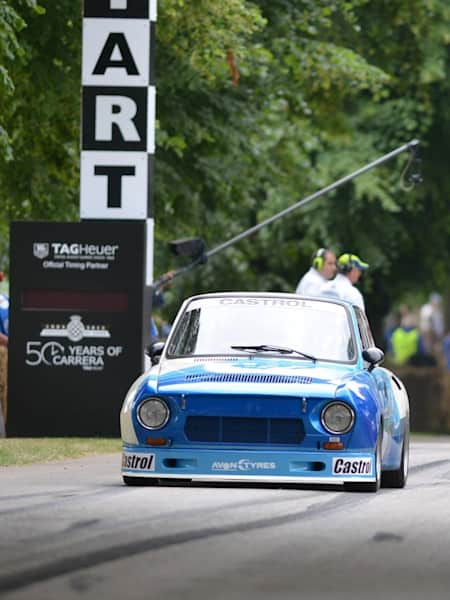Communism and motor racing don't really go together. While communism places the importance of comrade joining with fellow comrade and working together for the greater good above all else, a racing driver is up there with the world's worst bonus-grabbing city traders in terms of pure, single-minded selfishness – they were born to come first, and screw anyone who tries to get in their way. And if you don’t believe us, you need to re-watch the film Senna.
Racing is hardly a working man's sport either. You only need to go to an event like the UK's Goodwood Revival –a race meeting run by a Lord, no less – to see that motorsport is, outside of stock car and 2CV racing, a decadent, bourgeois pursuit (we love the Goodwood Revival, BTW).
Nonetheless, Soviet-era communism was known for its large-scale industrial manufacturing and its fondness for producing things made of pig iron. And if pig iron has one characteristic, it's that it's tough – and toughness in motor racing is a good thing.
Occasionally Eastern Bloc cars and drivers were even left off the leash to go – in a very un-communisty way – try and beat the crap out of their competition. Here's RedBull.com's seven best communist racing cars.
Lada Samara EVA
Is it just us or is the Group B World Rally Championship-spec Lada Samara EVA quite hot? It kind of looks like a mix between the best Group B cars of the era: a bit Lancia Delta S4 on the rear wheel arches, slightly Peugeot 205 T16-y at the front. Shame that Group B ended before Lada ever produced the 200 Samaras needed to homologate the car for the category.
Lada VFTS
Produced by the Vilnius Fabrik Tuning Sport company in Lithuania, the second Lada on our list (hey, we didn't say there were LOTS of communist racing cars) was also a Group B machine. The VFTS was based on the Zhiguli – or the Riva, Nova, Classic, Signet, Laika or Kalinka as it was known outside the Soviet Union – which in turn was based on the Fiat 124. Don't be fooled into thinking that the VFTS was some 600bhp snorting Group B monster though. The tinny little Russian only put out 240bhp.
Škoda 130 RS
If you wanted a rear-engined, rear-wheel-drive racing car in the 1970s but couldn't find enough money behind the sofa cushions for a Porsche 911, you could have done worse than the Škoda 130 RS. The car was used both in rallying and the European Toruing Car Championship in the 1970s and 1980s. It only produced around 130bhp from its little 1.4-litre four-cylinder engine, but crucially it only weighed a flyweight 780kg.
The Trabant
The Trabant is the ultimate symbol of Eastern Bloc automotive culture: an ugly two-door family car with a body made of recycled plastic and an inefficient two-stroke 600cc engine 'powering' it. But the Trabant was also light at 750kg, meaning tweaks to the engine, or putting in a new engine altogether, could seriously improve the power-to-weight ratio. That's how the the Trabusa – a Suzuki Hayabusa motorcycle engine-powered Trabant – came to be, and although a lot of Trabants were, and still are, used in local rallies in Eastern Europe, the height of the 'Trabi's' motorsport success was surely a bunch of them running as a race support to the 1988 Hungarian Grand Prix.
Polski Fiat 126
Another Soviet/Italian tie up, the cute Polski Fiat 126 provided a little Italian flare for families living in Poland in the 1970s and 80s. However, operating out of the city of Bielsko-Biała was the Polski Fiat works rally team, which turned out a number of smart looking and well prepped 126 Group 2 rally cars. OK, they weren't quite the Minis of their era in terms of results, but on its day, the fun-sized Fiat could stick it to Porsche 911s and Ford Escorts.
Lada Niva
The Niva (the Russian word for crop field) was Lada's answer to the Range Rover in the late-1970s. Luxurious it wasn't, but strangely if you go to the deserts of North Africa, you'll find a lot of Nivas kicking about. That's because, built to withstand the harsh conditions of a winter on a Russian farm, the Niva is extremely tough, and the simplicity of the design means that everything can be fixed easily. Competitors at the Paris-Dakar rally realised this, and started using the boxy Russian to take on the famously brutal rally. Just look at it go in the video below!
Tatra T-607 Monoposto
Tatra was a carmaker that never really got the memo from the Soviet government. Even at the height of communist rule, the Czech company was still building some lovely, aeroplane-inspired luxury cars like the swoopy V8-powered T-603, which was Fidel Castro's whip of choice. But Tatra also loved motorsports, and once racing resumed after World War II, the company developed the T-607 – adding a bit of mystique with the 'Monoposto' tag – to race in Formula One and Formula Two, which featured the same V8 engine as the T-603, but tuned up from 95bhp to 160bhp.






